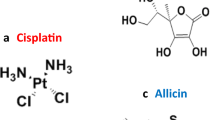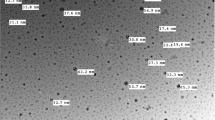Abstract
The use of cisplatin (CP) in chemotherapy of resistant cancers is limited due to its dose-dependent nephrotoxicity. Disulfiram (DSF), the aversion therapy for alcoholism, has recently emerged as an anticancer and chemopreventive agent. Its anticancer activity is potentiated in the presence of copper. However, such use of copper leads to several adverse effects. In the present study, the protective effect of DSF and its copper chelate (Cu-DEDC) against CP-induced nephrotoxicity in rats was evaluated. Nephrotoxicity was induced by a single intraperitoneal injection of CP (5 mg/kg). The treatment groups included control (vehicle treated), CP (CP-treated), CP + DSF (CP followed by DSF), CP + DSF + Cu (CP followed by DSF and CuCl2), CP + Cu-DEDC (CP followed by Cu-DEDC), and CP + AMF (amifostine pre-treated and CP-treated). The DSF, Cu-DEDC, and CuCl2 were administered orally at 50 mM/kg/day dose for 5 days post CP injection. AMF served as a standard chemo protectant, administered intravenously 30 min prior to CP. The markers of oxidative stress, inflammation, and kidney function estimated on the 6th day revealed that both DSF and Cu-DEDC significantly attenuated the CP-induced rise in the serum/urine creatinine and blood urea nitrogen (BUN). The CP-induced rise in serum alkaline phosphatase (ALPase) was reversed by these drugs. Both drugs reduced the levels of malondialdehyde and nitric oxide (NO) in kidney tissues. These drugs reversed CP-induced depletion of SOD, catalase, and GSH in the kidneys. There was a significant reduction in the CP-induced TNF-α and IL-1β production along with prevention of histological alterations. Above observations indicate that DSF and Cu-DEDC may have significance as adjuvants to protect against CP-induced nephrotoxicity.






Similar content being viewed by others

References
Ekborn A, Lindberg A, Laurell G, Wallin I, Eksborg S, Ehrsson H (2003) Ototoxicity, nephrotoxicity and pharmacokinetics of cisplatin and its monohydrated complex in the Guinea pig. Canc Chemotherap Pharmacol 51(1):36–42
Iraz M, Kalcioglu MT, Kizilay A, Karatas E (2005) Aminoguanidine prevents ototoxicity induced by cisplatin in rats. Ann Clin Lab Sci 35(3):329–335
Yao X, Panichpisal K, Kurtzman N, Nugent K (2007) Cisplatin nephrotoxicity: a review. Am J Med Sci 334(2):115–124
Guo Y, Wang M, Mou J, Zhao Z, Yang J, Zhu F, Pei G, Zhu H, Wang Y, Xu G (2018) Pretreatment of Huaiqihuang extractum protects against cisplatin-induced nephrotoxicity. Sci Rep 8(1):7333
Brewer C, Streel E, Skinner M (2017) Supervised disulfiram’s superior effectiveness in alcoholism treatment: ethical, methodological, and psychological aspects. Alcohol Alcohol 52(2):213–219
Jiao Y, N Hannafon B, Ding W-Q (2016) Disulfiram’s anticancer activity: evidence and mechanisms. Anti-Canc Agent Med Chem (Formerly Curr Med Chem-Anti-Can Agent) 16(11):1378–1384
Cheriyan VT, Wang Y, Muthu M, Jamal S, Chen D, Yang H, Polin LA, Tarca AL, Pass HI, Dou QP (2014) Disulfiram suppresses growth of the malignant pleural mesothelioma cells in part by inducing apoptosis. PLoS One 9(4):e93711
Allensworth JL, Evans MK, Bertucci F, Aldrich AJ, Festa RA, Finetti P, Ueno NT, Safi R, McDonnell DP, Thiele DJ (2015) Disulfiram (DSF) acts as a copper ionophore to induce copper-dependent oxidative stress and mediate anti-tumor efficacy in inflammatory breast cancer. Mol Oncol 9(6):1155–1168
Lewis DJ, Deshmukh P, Tedstone AA, Tuna F, O'Brien P (2014) On the interaction of copper (II) with disulfiram. Chem Commun 50(87):13334–13337
Navrátilová J, Jungová P, Vanhara P, Preisler J, Kanicky V, Smarda J (2009) Copper ions regulate cytotoxicity of disulfiram to myeloid leukemia cells. Int J Mol Med 24(5):661–670
Mitra S, Keswani T, Dey M, Bhattacharya S, Sarkar S, Goswami S, Ghosh N, Dutta A, Bhattacharyya A (2012) Copper-induced immunotoxicity involves cell cycle arrest and cell death in the spleen and thymus. Toxicol 293(1–3):78–88
Keswani T, Mitra S, Bhattacharyya A (2015) Copper-induced immunotoxicity involves cell cycle arrest and cell death in the liver. Environ Toxicol 30(4):411–421
Agarwal K, Sharma A, Talukder G (1990) Clastogenic effects of copper sulphate on the bone marrow chromosomes of mice in vivo. Mut Res Lett 243(1):1–6
Stewart DJ, Verma S, Maroun JA (1987) Phase I study of the combination of disulfiram with cisplatin. Am J Clin Oncol 10(6):517–519
Weijl N, Elsendoorn T, Lentjes E, Hopman G, Wipkink-Bakker A, Zwinderman A, Cleton F, Osanto S (2004) Supplementation with antioxidant micronutrients and chemotherapy-induced toxicity in cancer patients treated with cisplatin-based chemotherapy: a randomised, double-blind, placebo-controlled study. Euro J Cancer 40(11):1713–1723
Verma S, Stewart DJ, Maroun JA, Nair RC (1990) A randomized phase II study of cisplatin alone versus cisplatin plus disulfiram. Am J Clin Oncol 13(2):119–124
Fujie T, Murakami M, Yoshida E, Tachinami T, Shinkai Y, Fujiwara Y, Yamamoto C, Kumagai Y, Naka H, Kaji T (2016) Copper diethyldithiocarbamate as an activator of Nrf2 in cultured vascular endothelial cells. JBIC. J Biol Inorg Chem 21(2):263–273
Ilić S, Stojiljković N, Veljković M, Veljković S, Stojanović G (2014) Protective effect of quercetin on cisplatin-induced nephrotoxicity in rats. Facta Univ Ser Med Biol 16(2):71–75
Bami E, Ozakpınar OB, Ozdemir-Kumral ZN, Köroglu K, Ercan F, Cirakli Z, Sekerler T, Izzettin FV, Sancar M, Okuyan B (2017) Protective effect of ferulic acid on cisplatin induced nephrotoxicity in rats. Environment Toxicol Pharmacol 54:105–111
Shirwaikar A, Issac D, Malini S (2004) Effect of Aerva lanata on cisplatin and gentamicin models of acute renal failure. J Ethnopharmacol 90(1):81–86
Harlalka GV, Patil CR, Patil MR (2007) Protective effect of Kalanchoe pinnata pers.(Crassulaceae) on gentamicin-induced nephrotoxicity in rats. Ind J Pharmacol 39(4):201
Li W, Yan M-H, Liu Y, Liu Z, Wang Z, Chen C, Zhang J, Sun Y-S (2016) Ginsenoside Rg5 ameliorates cisplatin-induced nephrotoxicity in mice through inhibition of inflammation, oxidative stress, and apoptosis. Nutrient 8(9):566
Chaudhary G, Mahajan UB, Goyal SN, Ojha S, Patil CR, Subramanya SB (2017) Protective effect of Lagerstroemia speciosa against dextran sulfate sodium induced ulcerative colitis in C57BL/6 mice. Am J Transl Res 9(4):1792–1800
Borch RF, Pleasants ME (1979) Inhibition of cis-platinum nephrotoxicity by diethyldithiocarbamate rescue in a rat model. Proc Natl Acad Sci 76(12):6611–6614
Avi-Dor Y, Lipkin R (1958) A spectrophotometric method for the determination of reduced glutathione. J Biol Chem 233(1):69–72
Gore PR, Prajapati CP, Mahajan UB, Goyal SN, Belemkar S, Ojha S, Patil CR (2016) Protective effect of thymoquinone against cyclophosphamide-induced hemorrhagic cystitis through inhibiting DNA damage and upregulation of Nrf2 expression. Int J Biol Sci 12(8):944–953
Aswar M, Kute P, Mahajan S, Mahajan U, Nerurkar G, Aswar U (2014) Protective effect of hesperetin in rat model of partial sciatic nerve ligation induced painful neuropathic pain: an evidence of anti-inflammatory and anti-oxidative activity. Pharmacol Biochem Behav 124:101–107
Nicolás P, Lassalle VL, Ferreira ML (2017) Quantification of immobilized Candida antarctica lipase B (CALB) using ICP-AES combined with Bradford method. Enzym Microb Tech 97:97–103
Pezeshki Z, Khosravi A, Nekuei M, Khoshnood S, Zandi E, Eslamian M, Talebi A (2017) Time course of cisplatin-induced nephrotoxicity and hepatotoxicity. J Nephropath 6(3):163–167
Sherif IO (2015) Amelioration of cisplatin-induced nephrotoxicity in rats by triterpenoid saponin of Terminalia arjuna. Clin Exp Nephrol 19(4):591–597
Alhoshani AR, Hafez MM, Husain S, Al-sheikh AM, Alotaibi MR, Al Rejaie SS, Alshammari MA, Almutairi MM, Al-Shabanah OA (2017) Protective effect of rutin supplementation against cisplatin-induced nephrotoxicity in rats. BMC Nephrol 18(1):194
Zhang Y, Tao X, Yin L, Xu L, Xu Y, Qi Y, Han X, Song S, Zhao Y, Lin Y (2017) Protective effects of dioscin against cisplatin-induced nephrotoxicity via the microRNA-34a/sirtuin 1 signalling pathway. Br J Pharmacol 174(15):2512–2527
Vasaikar N, Mahajan U, Patil KR, Suchal K, Patil CR, Ojha S, Goyal SN (2018) D-pinitol attenuates cisplatin-induced nephrotoxicity in rats: impact on pro-inflammatory cytokines. Chem Biol Interact 290:6–11
Akca G, Eren H, Tumkaya L, Mercantepe T, Horsanali MO, Deveci E, Dil E, Yilmaz A (2018) The protective effect of astaxanthin against cisplatin-induced nephrotoxicity in rats. Biomed Pharmacother 100:575–582
Domitrovic R, Cvijanovic O, Susnic V, Katalinic N (2014) Renoprotective mechanisms of chlorogenic acid in cisplatin-induced kidney injury. Toxicol 324:98–107
Malik S, Suchal K, Gamad N, Dinda AK, Arya DS, Bhatia J (2015) Telmisartan ameliorates cisplatin-induced nephrotoxicity by inhibiting MAPK mediated inflammation and apoptosis. Eur J Pharmacol 748:54–60
Li Y, Fu SY, Wang LH, Wang FY, Wang NN, Cao Q, Wang YT, Yang JY, Wu CF (2015) Copper improves the anti-angiogenic activity of disulfiram through the EGFR/Src/VEGF pathway in gliomas. Canc Lett 369(1):86–96
Owunari GU, Minakiri SI (2014) Disulfiram and copper gluconate in cancer chemotherapy; a review of the literature. Can Res J 2(5):88–92
Tai Z, Cai L, Dai L, Dong L, Wang M, Yang Y, Cao Q, Ding Z (2011) Antioxidant activity and chemical constituents of edible flower of Sophora viciifolia. Food Chem 126(4):1648–1654
Niki E (2010) Assessment of antioxidant capacity in vitro and in vivo. Free Radic Biol Med 49(4):503–515
Al-Kahtani MA, Abdel-Moneim AM, Elmenshawy OM, El-Kersh MA (2014) Hemin attenuates cisplatin-induced acute renal injury in male rats. Oxid Med Cell Long:2014
Amirshahrokhi K, Khalili A-R (2015) Thalidomide ameliorates cisplatin-induced nephrotoxicity by inhibiting renal inflammation in an experimental model. Inflam 38(2):476–484
Motamedi F, Nematbakhsh M, Monajemi R, Pezeshki Z, Talebi A, Zolfaghari B, Mansoori A, Saberi S, Dehghani A, Ashrafi F (2014) Effect of pomegranate flower extract on cisplatin-induced nephrotoxicity in rats. J Nephropath 3(4):133
Korhonen R, Lahti A, Kankaanranta H, Moilanen E (2005) Nitric oxide production and signaling in inflammation. Curr Drug Target Inflam Allerg 4(4):471–479
Kuhad A, Tirkey N, Pilkhwal S, Chopra K (2006) 6-Gingerol prevents cisplatin-induced acute renal failure in rats. Biofact 26(3):189–200
Srivastava R, Farookh A, Ahmad N, Misra M, Hasan S, Husain M (1996) Evidence for the involvement of nitric oxide in cisplatin-induced toxicity in rats. Biomet 9(2):139–142
Jung M, Hotter G, Viñas JL, Sola A (2009) Cisplatin upregulates mitochondrial nitric oxide synthase and peroxynitrite formation to promote renal injury. Toxicol Appl Pharmacol 234(2):236–246
Chirino YI, Trujillo J, Sánchez-González DJ, Martínez-Martínez CM, Cruz C, Bobadilla NA, Pedraza-Chaverri J (2008) Selective iNOS inhibition reduces renal damage induced by cisplatin. Toxicol Lett 176(1):48–57
Lee KW, Jeong JY, Lim BJ, Chang Y-K, Lee S-J, Na K-R, Shin Y-T, Choi DE (2009) Sildenafil attenuates renal injury in an experimental model of rat cisplatin-induced nephrotoxicity. Toxicology 257(3):137–143
Kodama A, Watanabe H, Tanaka R, Kondo M, Chuang VTG, Wu Q, Endo M, Ishima Y, Fukagawa M, Otagiri M (2014) Albumin fusion renders thioredoxin an effective anti-oxidative and anti-inflammatory agent for preventing cisplatin-induced nephrotoxicity. BBA Gen Subj 1840(3):1152–1162
Ali BH, Abdelrahman AM, Al-Salam S, Sudhadevi M, AlMahruqi AS, Al-Husseni IS, Beegam S, Dhanasekaran S, Nemmar A, Al-Moundhri M (2011) The effect of sildenafil on cisplatin nephrotoxicity in rats. Bas Clin Pharmacol Toxicol 109(4):300–308
Author information
Authors and Affiliations
Corresponding author
Ethics declarations
Experimental procedures involving the use of laboratory animals were approved (protocol approval no. IAEC/CPCSEA/RCPIPER/2017-15) by the Institutional Animal Ethics Committee (IAEC) of the R. C. Patel Institute of Pharmaceutical Education and Research, Shirpur, Dist. Dhule (M.S.), India (reg. no. 651/PO/ReBi/S/02/CPCSEA) constituted under the “Prevention of Cruelty to the Animals Act- 1960.” All the experiments were carried out according to the guidelines prescribed by the Committee for the Purpose of Control and Supervision of Experiments on Animals (CPCSEA), Government of India.
Conflict of Interest
The authors declare that they have no conflict of interest.
Additional information
Publisher’s Note
Springer Nature remains neutral with regard to jurisdictional claims in published maps and institutional affiliations.
Rights and permissions
About this article
Cite this article
Khairnar, S.I., Mahajan, U.B., Patil, K.R. et al. Disulfiram and Its Copper Chelate Attenuate Cisplatin-Induced Acute Nephrotoxicity in Rats Via Reduction of Oxidative Stress and Inflammation. Biol Trace Elem Res 193, 174–184 (2020). https://doi.org/10.1007/s12011-019-01683-w
Received:
Accepted:
Published:
Issue Date:
DOI: https://doi.org/10.1007/s12011-019-01683-w



